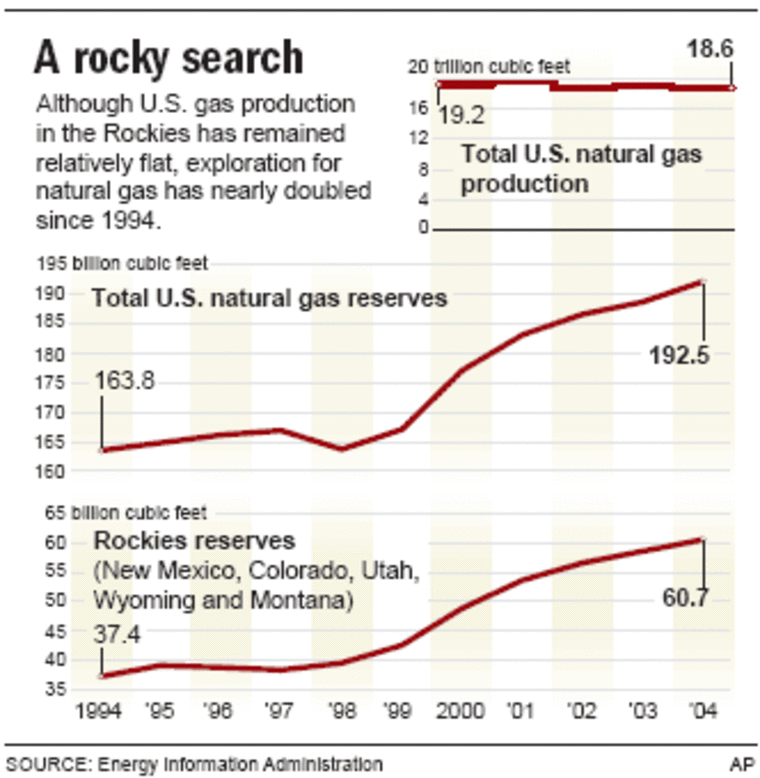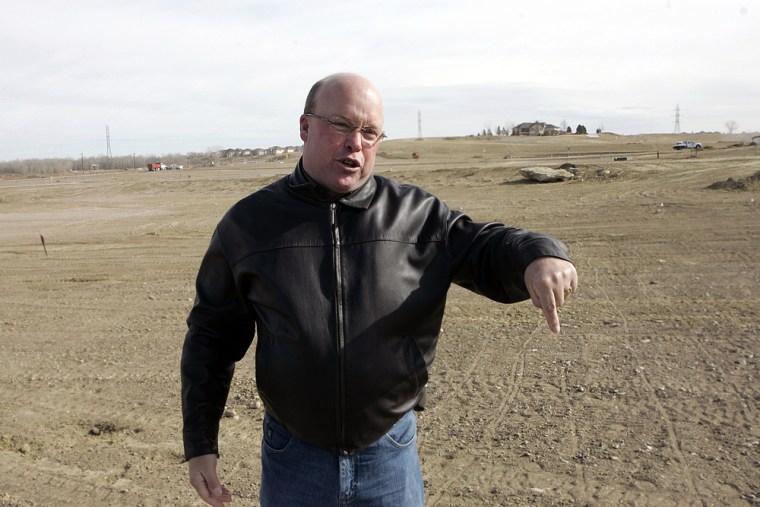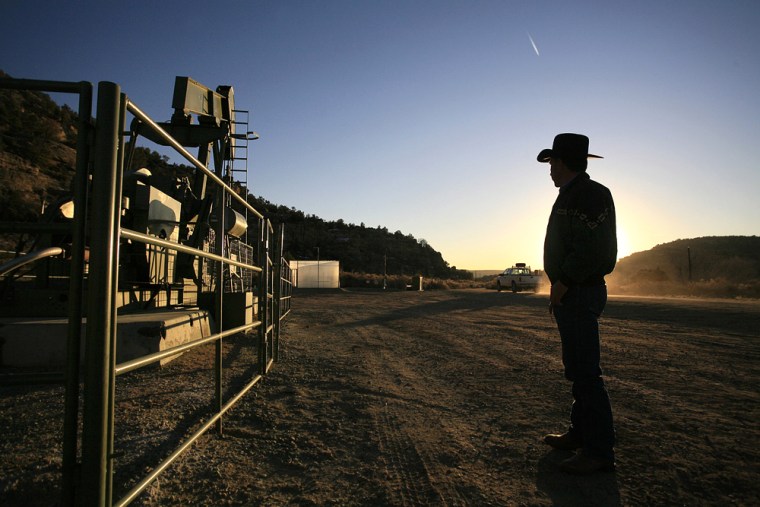On a blustery winter day on the rolling plains north of Denver, a herd of cattle stood grazing a few yards from an idled natural gas pump in a dormant field as traffic rumbled by along a black-topped, two-lane highway.
Just down the road are shopping centers and subdivisions packed with new homes, gobbling up land around this once-sleepy agricultural town that just happens to sit atop the Wattenberg gas field, one of the nation’s most productive.
Ed Orr knows this land well. A rancher and developer whose family roots in Colorado date back more than a century, Orr says the real estate business is growing increasingly difficult because gas producers want access no matter what the plans are for the property.
“The conflict of the cultures is certainly more prevalent. You have two industries that are both growing,” Orr said. “They think that we have no valid rights to get any accommodation for development use of the surface.”
Twin engines of growth — in population and within the oil and natural gas industry — are colliding in Greeley, the fastest-growing metropolitan area in the nation. Developers looking to cash in on rising land values are running into companies eager to sink more wells and drawing up plans for multibillion-dollar pipelines to carry gas to the East Coast.
Similar conflicts are playing out from Montana to New Mexico because the Rockies’ energy boom is in full bloom, prompting worries about the environment, property rights and the changing character of small towns swelling with new workers. Many fear another Western rush to fortune will be followed by hard times — again.
Long-term boom?
The gas boom, however, seems to be setting up for an extended run, according to industry experts. That poses a new set of issues for communities that have diversified their economies by attracting tourism, manufacturing, construction and technology companies after the last bust in the 1980s. Cities such as Grand Junction and Montrose in western Colorado have become havens for retirees, while mountain communities that are home to celebrity-magnet ski resorts are filled with wealthy property owners who buy up ranches and build second homes.

Even as the West’s population grew by nearly 20 percent in the 1990s, the oil and gas industry has returned its focus to the Rockies thanks to skyrocketing prices and technology that make the resources easier to retrieve. Drilling has slowed in other gas fields, and Hurricane Katrina forced Gulf Coast-oriented companies to consider other options.
Producers — including EnCana Corp., Kerr-McGee Corp., Noble Energy Inc. and Bill Barrett Corp. — are sinking traditional oil and gas wells across the West, tapping coal-bed methane reserves and are even experimenting with hard-to-get resources such as oil shale.
According to federal statistics, U.S. gas production has been relatively flat for years (18.1 trillion cubic feet in 1993 compared with 18.6 tcf in 2004). But exploration is red-hot: In New Mexico, Colorado, Utah, Wyoming and Montana, gas reserves in 2004 totaled 60.7 billion cubic feet, up from 58.8 billion cubic feet in 2003. And the number of producing wells rose from 73,796 in 2000 to 84,164 in 2004.
The quick pace of production has filled pipelines to capacity, prompting at least three new pipeline proposals, including a $20 billion project to bring gas from Alaska’s North Slope to the Midwest. The other projects are in the West.
‘Infancy’ stage
“The Rockies is sort of in its infancy,” said Ron Gist, senior principal of Purvin and Gertz Inc., an industry consulting company in Houston. “One of the reasons the Rockies has not been developed as quickly is the local demand isn’t that big so then you need an infrastructure to get it to market.”
Kinder Morgan Energy Partners LP and Sempra Energy are building a $4 billion, 1,323-mile pipeline to carry up to 2 billion cubic feet of natural gas from Colorado’s Weld County — home to Greeley — to Monroe County, Ohio, for delivery to Midwestern and Eastern markets by June 2009. Kinder Morgan is also expected to buy another pipeline from EnCana that will run from Rio Blanco County in western Colorado through Wyoming to the Weld County hub.
Separately, El Paso Corp. has proposed a 1,000-mile pipeline called the Continental Connector to move up to 2 billion cubic feet of natural gas from Weld County to Kansas and then into existing pipelines that serve markets in the Midwest, Southeast and Northeast. The costs have not been disclosed but El Paso said it could be in operation by November 2008.
Don Santa, president of the Interstate Natural Gas Association of America, said the companies will need adequate pledges from producers for gas before they can get federal approval for the sprawling projects. He said rising levels of production and the need for gas in the East suggests a need for the Kinder Morgan-Sempra and El Paso projects.
“Those two are of a magnitude that we haven’t seen in a while,” he said.
Most analysts believe the gas boom will remain strong, noting there is an insatiable demand not only in the United States but overseas.
“We’re looking for continued production increases for 10, 15 years at least and perhaps longer than that,” Gist said. “Our view of things out to 2020 has gas production in the region continuing to increase. This is indeed a long-term trend.”
Boom skeptics
Environmentalists are increasingly concerned the operations could threaten wilderness areas, wildlife habitat, the air and water supplies. Pete Morton, an economist with The Wilderness Society in Denver, isn’t sure how long the boom will last, given the cyclical nature of resource industry.
“When you see this almost universal response of, ‘Oh, high prices are here to stay and demand is here to stay,’ that’s when you know it’s not going to happen,” Morton said. “These are the same people who were telling you to buy high tech before the bubble burst.”
When liquefied natural gas imports become common and cheap gas from overseas starts flowing, he said, “boom, the Rockies lose out.” EnCana, meanwhile, recently cut $800 million from its capital spending forecast for 2006.
Still, the boom has already overwhelmed towns lacking adequate housing, social services and infrastructure, and authorities say it has led to more crime. A labor shortage is hitting energy companies and businesses trying to serve them.
In bustling Rock Springs, Wyo., energy workers have filled all 1,850 motel rooms. On any given day, there are more than 500 available jobs posted with the Sweetwater County Economic Development Association, though director Pat Robbins said as many as 1,000 jobs may be open.
For example, Halliburton would like to double its work force of 755 and Wal-Mart needs about 200 people to be fully staffed, Robbins said. She and her counterparts in Campbell and Natrona counties recently held job fairs in Michigan in hopes of landing laid-off auto workers.
County voters, meanwhile, recently approved a tax increase to help pay for improvements including repairs for hundreds of miles of dirt roads leading to oil-and-gas operations, Robbins said. Despite the headaches, she said the town of 23,000 people welcomed the growth.
“I got excited when Halliburton did their new building,” Robbins said. “Other people got excited when IHOP opened.”
Highest and best use?
The boom also has taken its toll on ranchers, developers and homeowners who have little recourse when an oil company with underground mineral rights elects to drill on their land.
Rancher Chris Velasquez believes his cattle have suffered because of problems associated with oil-and-gas drilling on 22,000 acres he leases east of Farmington, N.M. There has been lost forage and he has had cows killed in collisions. He said his calves have lost weight and hair.
“They have affected my operation a lot,” he said. “It’s an ongoing thing.”
He isn’t opposed to energy production but wants the companies to be responsible. If the problems continue, he says he may have to sell the herd and find another line of work.

Orr, the developer, bought property along the Poudre River west of Greeley several years ago where he wintered his cattle. As the population grew, a golf course was built nearby and then a high school, both of which made ranching more difficult.
Today, he has turned that ranch into a mixed-use subdivision and become primarily a developer with a small herd of cattle. He plans to develop gas wells on his property.
“There’s an agriculture way of life that you know certainly has some emotion tied to it and that you hate to see go away — but on the other hand I see it as progress and I think that change is good,” he said. “I think that ultimately all property should reach its highest and best use. In this area that is no longer raising cows.”
